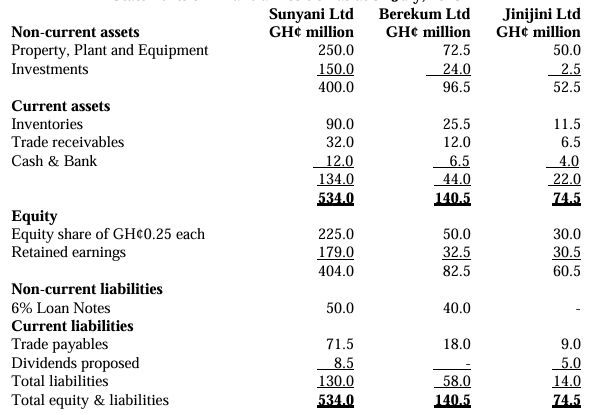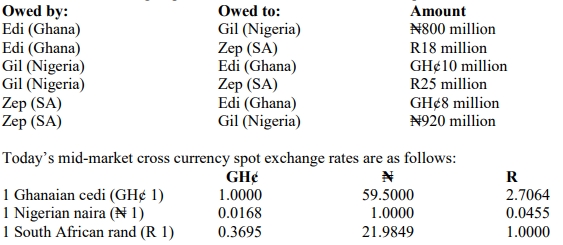Sunyani Ltd (Sunyani) is a limited liability company based in Brong Ahafo. It has shareholdings in two other companies, Berekum Ltd (Berekum) and Jinijini Ltd (Jinijini). Sunyani bought 150 million ordinary shares in Berekum on 1 August 2016, when the retained earnings of Berekum were GH¢22 million. The consideration was agreed at GH¢110 million for these shares.
On 1 August 2017, Sunyani bought a 40% holding in the ordinary shares of Jinijini when the retained earnings balance in Jinijini’s books stood at GH¢26 million. The consideration was an immediate cash payment of GH¢25 million. The directors of Sunyani negotiated the right to appoint 4 directors to Jinijini’s 12-person board as a result of its investment.
Statements of Financial Position are shown below for all three companies as at 31 July 2018.
Statements of Financial Position as at 31 July 2018:

Additional Information:
i) At the date of acquisition, Sunyani conducted a fair value exercise on Berekum’s net assets, which were equal to their carrying amounts with the following exceptions:
- A property held by Berekum had a fair value GH¢10 million in excess of its carrying value. 75% of the value of this property relates to buildings with a useful economic life of 10 years at the date of acquisition.
- Berekum had an unrecorded deferred tax liability of GH¢7 million, which was unchanged as at 31 July 2018.
ii) Sunyani’s policy is to value any Non-Controlling Interests (NCI) at their proportionate share of identifiable net assets at the acquisition date.
iii) Immediately after the acquisition, Berekum issued GH¢40 million of 6% loan notes, GH¢8 million of which were bought by Sunyani Ltd. This investment has been correctly recorded in the books of Sunyani under the heading “Investments.” All interest due on loan notes as at 31 July 2018 has been paid and recorded.
iv) During the financial year ended 31 July 2018, Berekum had sold goods to Sunyani amounting to GH¢30 million. The purchase price included a mark-up of 20% on cost. Berekum’s normal mark-up on goods sold is 60%. Of these goods, one-quarter remained in the closing inventory of Sunyani at the reporting date.
v) Sunyani has not accounted for any dividend receivable from its group companies. Both Sunyani and Jinijini have proposed dividends as shown in current liabilities. Jinijini’s proposed dividend relates entirely to the post acquisition period. No other dividends were paid or proposed in the year.
vi) Recorded in the books of Sunyani was an intra-group trade payable of GH¢10 million owed to Berekum at year-end. However, the books of Berekum showed a balance of GH¢11 million owed by Sunyani. It transpired that Berekum’s computer system had automatically charged to Sunyani’s account, interest of GH¢1 million due to late payments. It was subsequently agreed that Berekum would waive this interest.
vii) There were no impairment losses during the year end 31 July 2018.
(All workings may be rounded to the nearest GH¢0.01m)
Required: Prepare the Consolidated Statement of Financial Position for the Sunyani group as at 31 July 2018 in accordance with International Financial Reporting Standards.




